Dumbbells can be highly effective when progressive overload is applied correctly. Overloading requires you to increase exercise intensity as you progress with your training. But how do you do this? This article explains how to correctly apply progressive overload to your dumbbell training.
Progressive overload with dumbbells is achieved by increasing weight, reps, sets, or training days. It can also be achieved by decreasing the rest duration between sets or slowing the tempo for each repetition. Beginners are recommended to apply one method at a time to avoid overtraining.
If you make the same mistake I made as a beginner (by not overloading enough), you may end up 1 year into your training with very little results to show (which is exactly what happened to me).
Today, I’ll be sharing my research and experience with progressive overload, and how you can avoid my mistake.
I’ll explain exactly when you should add weight to your dumbbells, as well as how to do it properly.
Let’s jump right in!
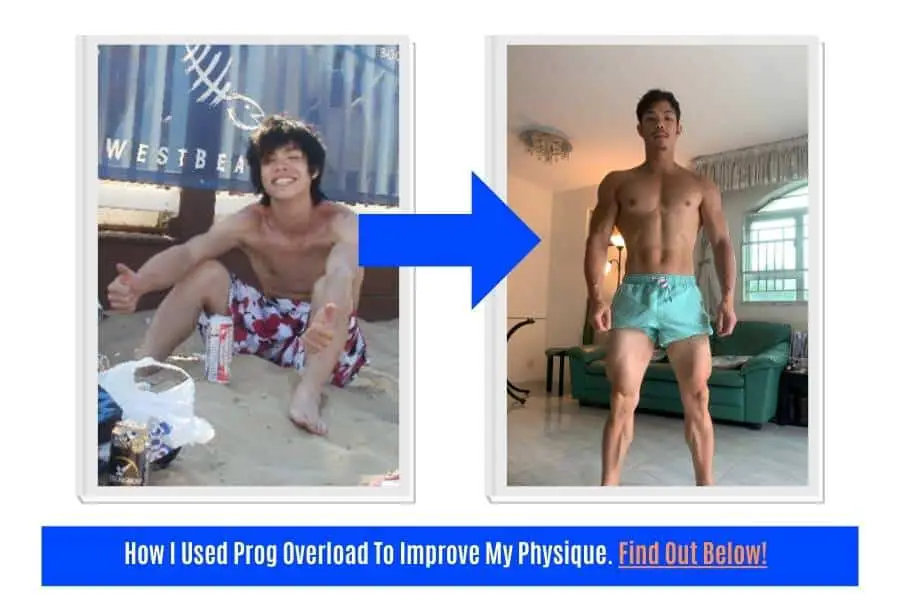
- What Is Progressive Overload?
- How To Progressive Overload With Dumbbells
- When To Increase Dumbbell Weight
- 8 Signs You Should Increase Dumbbell Weight
- How Often Should You Increase Dumbbell Weight?
- How Much Weight To Add To Dumbbells
- 8 Ways To Increase Weight On Existing Dumbbells
- What Happens When You Train With The Same Weight?
- Recommended Gear For Effective Dumbbell Progressive Overload
- Conclusion
What Is Progressive Overload?
Progressive overload is the principle of increasing exercise intensity over a period of time to make weight training more difficult. This maintains the presence of a challenging stimulus to a muscle. Progressive overload is essential for achieving continued size and strength gains.
Overloading is an important principle in weight training.
Why?
If your workouts are too intense for your current abilities, then the likelihood of bad lifting form and injury also increases.
Conversely- if you’re workouts are too easy, you may not get the training results you were expecting to see.
Therefore it’s essential to find the right balance.
You should use a training intensity that challenges you now, and continue making that exercise more difficult as you become stronger and fitter.
The main methods to progressive overload are to:
- Increase weight.
- Do more sets.
- Do more reps.
- Decrease inter-set rest duration.
- Increase number of training days.
- Prolong lifting tempo.
Regardless of your workout routine, the principles of progressive overload should be applied to all exercises in a program.
You may be interested in checking out my other article to find out what happens when you lift weights every day and why it’s not recommended!
How To Progressive Overload With Dumbbells
Whilst all overload methods can be used for all the major training goals (muscle-building, fat-burning, or cardio), some methods are more suitable for different goals than others. And it’s no exception for dumbbells either.
Here’s how to apply progressive overload to your dumbbell training and the primary purpose it serves:
| Dumbbell Overload Method | Example | Purpose: |
|---|---|---|
| Increase weight | Add 10lbs to each dumbbell. | Build muscle, strength, tone, and definition |
| Increase sets | Doing 4 sets rather than 3 sets. | Build muscle, strength, tone, and definition. |
| Increase reps | Doing 12 reps rather than 8 reps. | Build muscle, strength, tone, fat-burning, and definition. |
| Increase training frequency | Adding an extra training day to your weekly dumbbell program | Increasing intensity when current dumbbell weight is maxed out. |
| Decrease inter-set rest | Resting for 30 seconds instead of 60 seconds between each set. | Fat-burning, cardio, and HIIT. |
| Decrease lifting tempo | Counting for 2 seconds on the up phase and 4 seconds on the down phase. | Increasing intensity when current dumbbell weight is maxed out. |
The most popular method for dumbbell progressive overload is to simply increase the weight.
This increases training intensity and can be great for the purpose of building muscle as well as for burning fat and increasing definition.
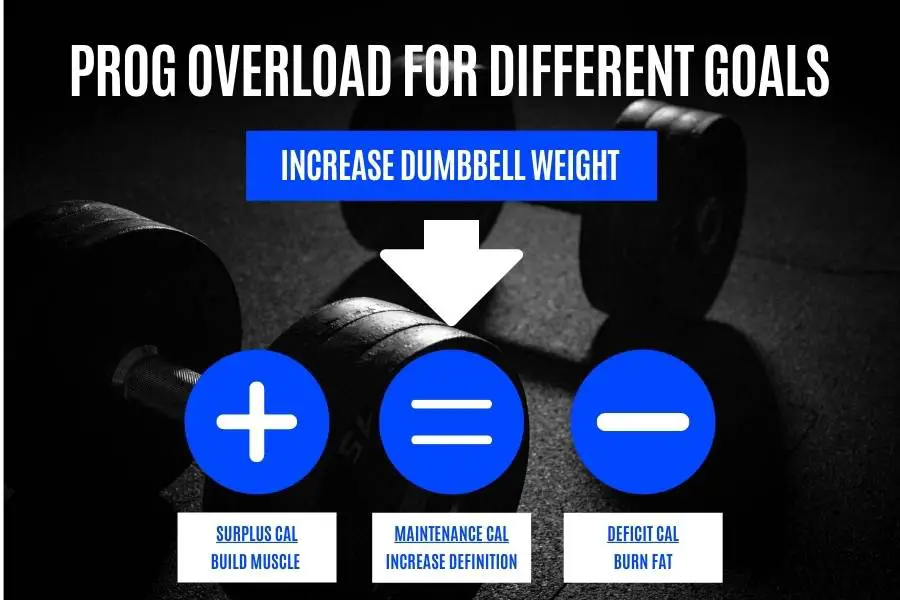
The results you get from increasing dumbbell weight are ultimately determined by your nutrition:
- Caloric surplus- build muscle.
- Maintenance calories- build muscle, lose fat, and increase definition.
- Caloric deficit- burn fat.
When To Increase Dumbbell Weight
Dumbbell weight should be increased whenever it becomes easy to complete the current number of sets and reps. Each set should induce muscular fatigue within the last 1-3 reps of a set. If this does not occur, then it is recommended to increase dumbbell weight.
Remember- the first few reps of a set are performed to bring your muscles closer to fatigue. The “money-maker” reps are actually the last few that cause fatigue. These are the reps that induce the positive results associated with training.
Here’s an example of how an ideal set of 8 reps should feel like:
| Rep Number | Feeling | Training Benefits |
|---|---|---|
| 1 | Extremely easy | No effect |
| 2 | Very easy | Very little effect |
| 3 | Easy | Little effect |
| 4 | Moderate | Moderately little effect |
| 5 | Getting harder | Medium effect |
| 6 | Fatigue onset | Moderately high effect |
| 7 | Noticeable fatigue | High effect |
| 8 | Very little energy for more reps | Very high effect |
If you’re still not feeling muscle fatigue by the last rep, then this is a strong indication that you should apply progressive overload by adding weight to your dumbbell.
The “2 for 2 rule” is another way you can determine when to add weight to your dumbbells:
“When you’re able to do two additional reps in your last set of an exercise for two weeks in a row, it’s time to increase the weight”
Menshealth
8 Signs You Should Increase Dumbbell Weight
So how do you gauge when fatigue begins to set in? How do you know for sure it’s time to apply progressive overload to your dumbbell training?
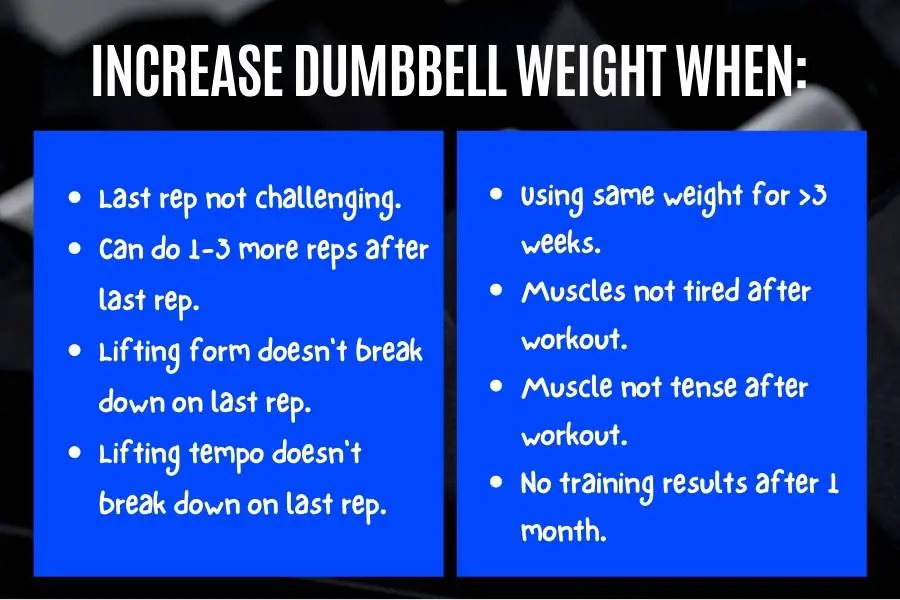
Here are 8 more signs that indicate you should increase dumbbell weight:
- Last rep does not feel challenging. If the last rep in a set does not feel challenging, then this is a good sign you need to increase intensity.
- Able to do 1-3 more reps after the last completed rep. If you still have the confidence to squeeze 3 more reps after a full set, then you should consider increasing dumbbell weight.
- Lifting form does not break down on the last 1-3 reps. If you’re able to complete all reps with perfect form, then this can indicate that you need to make the exercise more challenging.
- Lifting tempo does not decrease by the last 1-3 reps. If you can complete rep #1 and rep #8 with a similar up/down speed, then this may indicate you should add more weight to increase difficulty.
- Using the same weight for over 3 weeks. Training with the same weight for so long is a good sign that you should consider adding weight to your dumbbells.
- Muscles don’t feel tired after a workout. Lack of a noticeable strength decline immediately after a workout signifies that your muscles aren’t being adequately challenged during the workout.
- Muscles don’t feel tense after a workout. A lack of a noticeable tension, or “pump” after a dumbbell workout signifies you should increase weight.
- No noticeable training effects within a month. If after a month you still don’t see training results, it could be because you aren’t pushing yourself hard enough.
If you notice more than 1 of these signs, then it’s time to increase dumbbell weight!
How Often Should You Increase Dumbbell Weight?
An average beginner to intermediate should aim to increase dumbbell weight once every 1-2 weeks in a linear style progression. Individuals who are trying to break strength plateaus should increase dumbbell weight once per month with variations in reps and sets in a block style progression.
What’s the difference between linear and block progression?
Linear progression requires you to add a similar amount of dumbbell weight per period of time without changing the sets and reps.
For example: in weeks 1 and 2 you’ll do 50lbs x 3 sets x 8 reps. And weeks 3 and 4 you’ll do 55lbs x 3 sets x 8 reps. This cycle repeats itself in a linear fashion
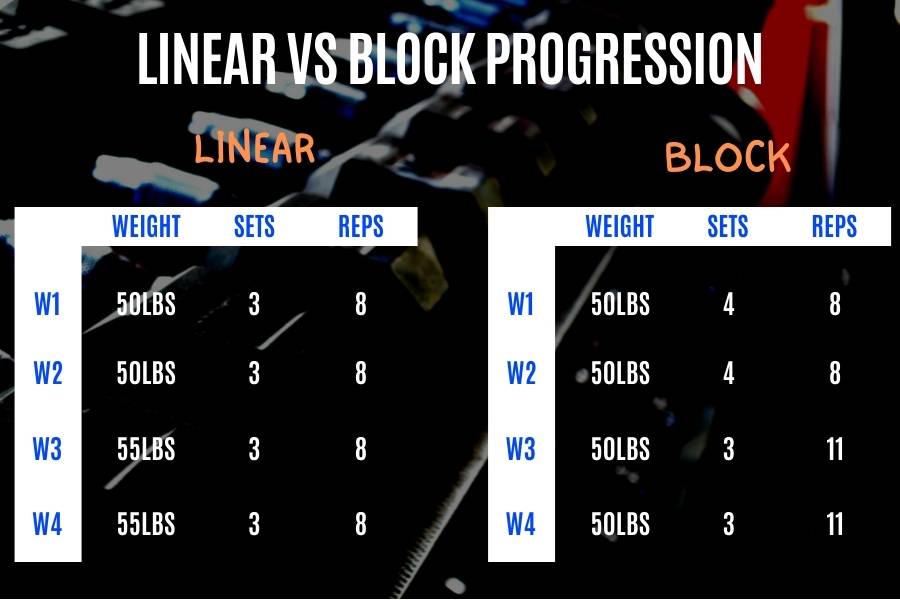
Block progression involves spending an entire month working with the same dumbbell weight but increasing the reps and sets (one method at a time).
For example: in weeks 1 and 2 you’ll do 50lbs x 4 sets x 8 reps. And weeks 3 and 4 you’ll do 50lbs x 3 sets x 11 reps. Then the following month, you’ll increase the weight to 65lbs and repeat the cycle.
Both methods are effective.
Linear progression has you increasing dumbbell weight 2 to 4 times per month, making for faster gains.
But block progression involves increasing dumbbell weight once per month, making it slower but more effective for breaking strength plateaus.
How Much Weight To Add To Dumbbells
Generally speaking, it is recommended to increase dumbbell weight by 5-10% of the current weight. On average, this equates to increasing each dumbbell by approximately 2.5lb to 10lbs per dumbbell. The exact amount of weight added will be influenced by the type of exercise.
Therefore the maximum weight you should ever need to add to your dumbbells should not be more than 10lbs per dumbbell (unless you’re lifting 100lb+ dumbbells).
There’s no recommendation for minimum added weight. In fact, the smaller the weight increment the better since a smaller increment also increases the likelihood that you can successfully lift that weight.
That being said, most dumbbell increments come at a minimum of 5lbs per dumbbell, preventing you from overloading with anything less.
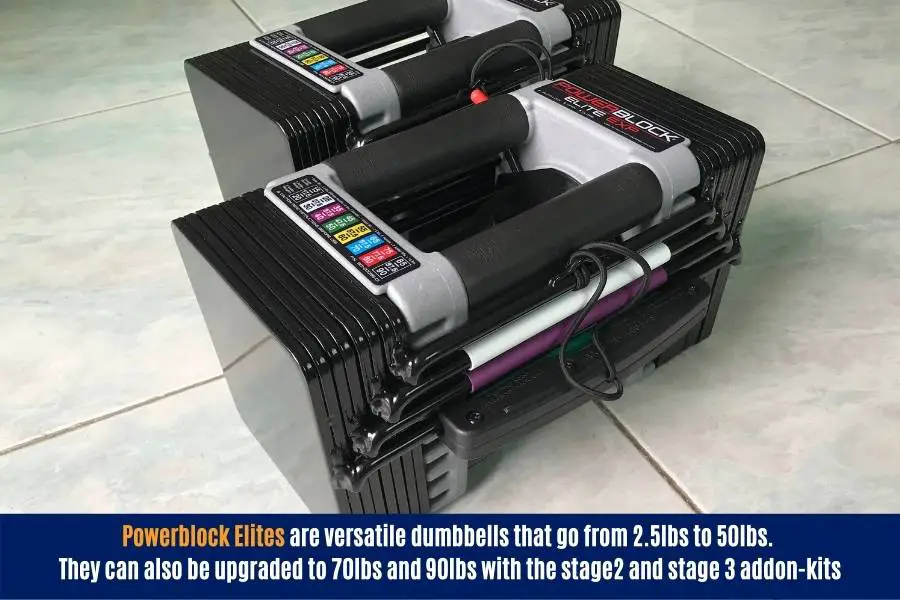
The best dumbbells have 2.5lb increments which are great for progressive overloading with.
I use the Powerblock Elites (you can find my hands-on review here). But folks from the UK will find the Powerblock Pro’s to be much cheaper.
| Upper Body Dumbbell Exercises (+5% Weight) | Lower Body Dumbbell Exercises (+10% Weight) |
|---|---|
| Bench press | Goblet squat |
| Dumbbell chest fly | Dumbbell squat |
| Shoulder press | Front squat. |
| Lateral raise | Pile squat |
| Dumbbell row | Bulgarian split squat |
| Reverse fly | Pistol squat |
| Weighted sit-up | Step up |
| Bicep curl | Lunge |
| Tricep extension | Deadlift |
| Dumbbell pullover | Calf raise |
You should also follow the upper-lower body 5-10% rule. This recommends you to progressive overload upper body dumbbell exercises by no more than 5% and lower body lifts by no more than 10% (see table above).
“Generally, you should limit weekly weight increases for any given lift to no more than 10%”.
Aleisha Fetters, C.S.C.S Strength Coach.
Regardless of your chosen weight increase, you should always make sure you can lift the dumbbell with good form.
If you’re looking for a new pair of dumbbells, it’s important to choose the right weight. You can check out my other article to find out the Ideal dumbbell KG for your personal ability.
8 Ways To Increase Weight On Existing Dumbbells
Extra weight can be added to existing dumbbells with a variety of accessory items. The best ways to increase dumbbell weight capacity include wrist weights, magnetic microplates, and resistance bands. These will increase the resistance provided by your current dumbbells.
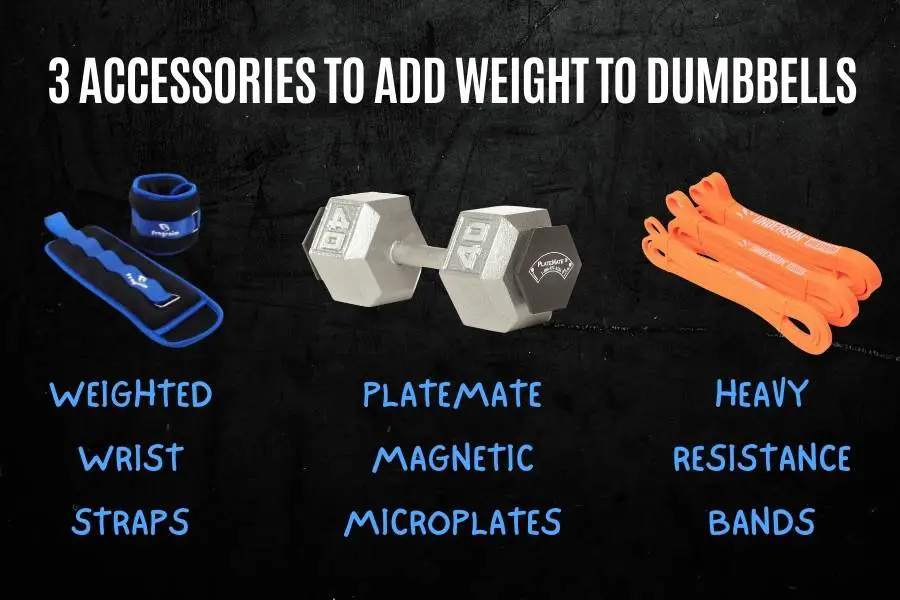
These methods are great for applying progressive overload when you’ve already maxed out the built-in weight capacity of the dumbbell.
You can also make your dumbbell exercises more difficult by increasing training frequency and reducing lifting tempo.
How to use each method.
Here’s a lowdown for the methods you can use to increase difficulty on dumbbell lifts:
- Wrist weights. These can be strapped to the wrists to add weight to your current dumbbells. Multiple weights can be strapped to your wrist to create the desired resistance. These Fragraim wrist weights are made from heavy-duty cotton and velcro, and go up to 7.5lbs per weight.
- Magnetic microplates. These are magnetic weight plates that stick to the ends of your dumbbells to increase resistance. Platemate is a reputable company. They make microplates that weigh 0.25lbs, 0.50lbs, and 1.25lbs per plate. They work well on all uncoated dumbbells and even work on some urethane-coated dumbbells (check the reviews to be sure).

- Resistance bands. These can be wrapped around the handles of your dumbbells to increase resistance. I use the Undersun bands (check out my review here) which offer one of the highest resistance levels on the band market. They also come with a lifetime warranty (not seen on any other brand). You can even use them as a standalone way to train the whole body. If that’s something you’re interested in, I’d recommend getting some cheap gloves like the Ihuans to protect your hands from friction burn.
- Increase training frequency. Adding 1 or 2 extra training days is a cost-free and effective way to progressive overload on a dumbbell that’s already maxed out on its current weight capacity.
- Increase lifting tempo. Count for 2 seconds on the downward phase and 4 seconds on the upward phase. This is called time under tension (TUT) training to increase the intensity of your dumbbell lifts!
- Increase range of motion. This can be done by dropping the dumbbells lower than usual. For example, allow the dumbbells to fully touch the chest before pressing them up on a bench press or drop your butt fully to the floor on a goblet squat! Increasing range of motion makes the exercise harder to perform.
- Introduce a split-pause. As you finish the downward phase, hold the contraction for a split second before driving the dumbbells back up. You can even pause halfway through a downward/upward phase. This makes the dumbbell exercise harder and it’s a free way to progressive overload.
- Use a combination approach. Combine multiple methods for the greatest benefits! I wouldn’t recommend beginners combining more than 2 methods at one time though.
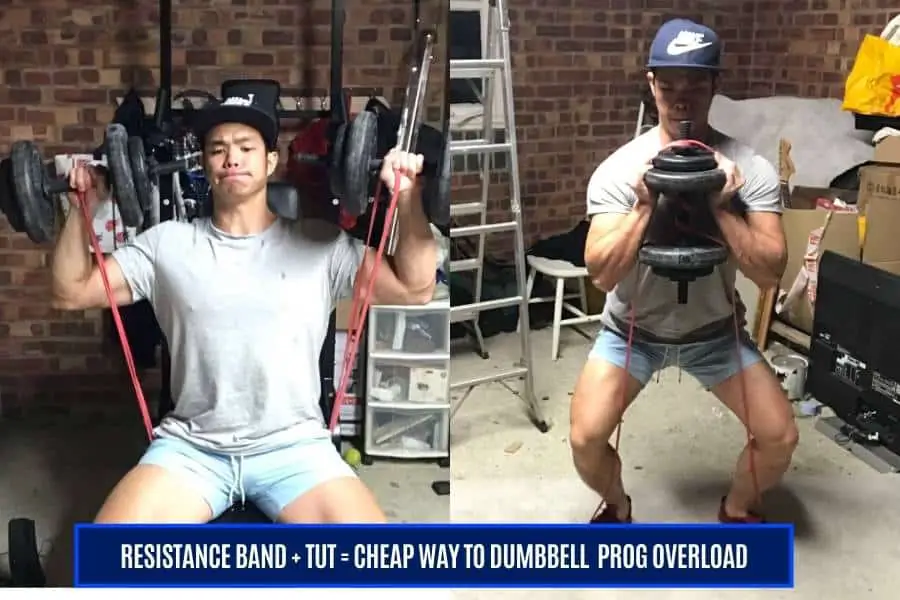
My favorite method is to combine resistance bands, dumbbells, and TUT training to make my dumbbell workouts really challenging!
What Happens When You Train With The Same Weight?
Training with the same weight for an extended period of time will increase the likelihood of a strength plateau. This occurs because muscles undergo metabolic adaptations to training. And when a challenging weight stimulus is no longer present, the muscle stops growing.
Just to give you an idea- here are my dumbbell workout results with and without progressive overload:
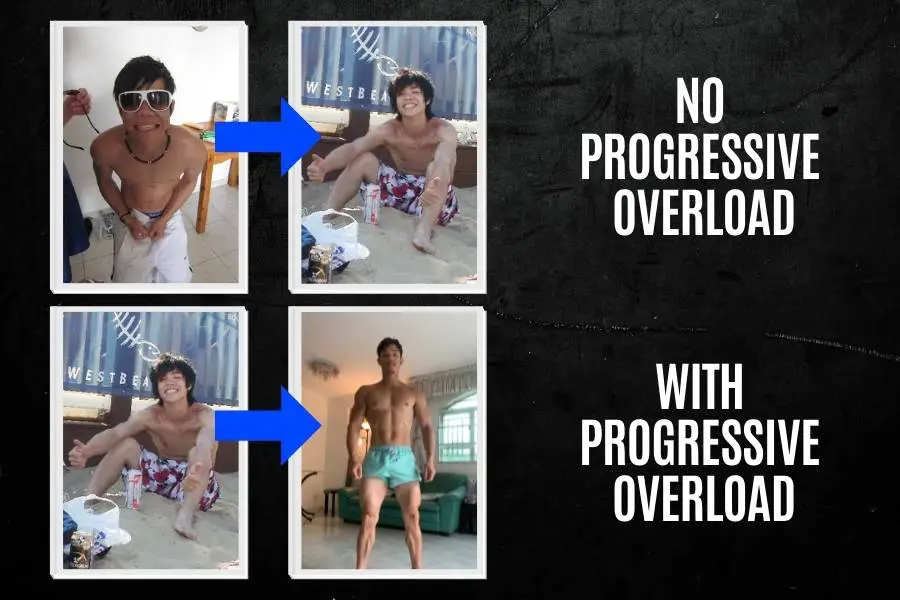
Even if your goal isn’t to build muscle, you should still apply overload to your dumbbell training.
It takes months of heavy lifting combined with a caloric surplus to get bigger.
If you apply progressive overload without a caloric surplus, you’ll find that you burn fat quicker and become more lean, toned, and defined!
You might be interested in my other article which details exactly how I built a V-shaped body with dumbbells!
Recommended Gear For Effective Dumbbell Progressive Overload
Here’s a recap of all the recommended gear to apply progressive overload effectively at home with dumbbells:
| Product | Why It’s Great For Progressive Overload |
|---|---|
| Powerblock Elite | Features a 90lb max capacity (with addon kit) and small 2.5lb increments. Small increments are ideal for efficient progressive overload. |
| Powerblock Pro | Cheapest Powerblock in the UK. Similar to the Elites but they only come with 5lb increments. Still great for progressive overloading. |
| Wrist weights | Cheap way to increase the weight on dumbbells that have already been maxed out. |
| Magnetic microplates | Durable way to increase the weight on dumbbells that have already been maxed out. |
| Resistance bands | Attach them to your dumbbell handles and combine them with TUT training to make your dumbbell exercises twice as hard! |
Conclusion
I’ve explained how you can apply progressive overload to your dumbbell training, explained when to increase weight, and described how to increase weight.
No matter what your training goal is, it’s important to apply progressive overload by increasing weight on a regular basis.
If your goal is to build muscle- overload is essential to build strength and mass (assuming you’re on a caloric surplus).
If you goal is to burn fat- overload will help you to burn more calories from your dumbbell workouts (assuming you’re on a caloric deficit).
What’s your favorite dumbbell progression method?
Let me know in the comments!
You may also be interested in the downloadable Kalibre Blueprint PDF which details exactly how I gained 40lbs of lean muscle (it’s 100% free!). It details the exact exercises and nutrition I used to go from skinny to ripped!
Thanks for reading guys!
Peace Out,
Kal
(Biochemistry BSc, Biomedical Sciences MSc, Ex-Skinny Guy)


